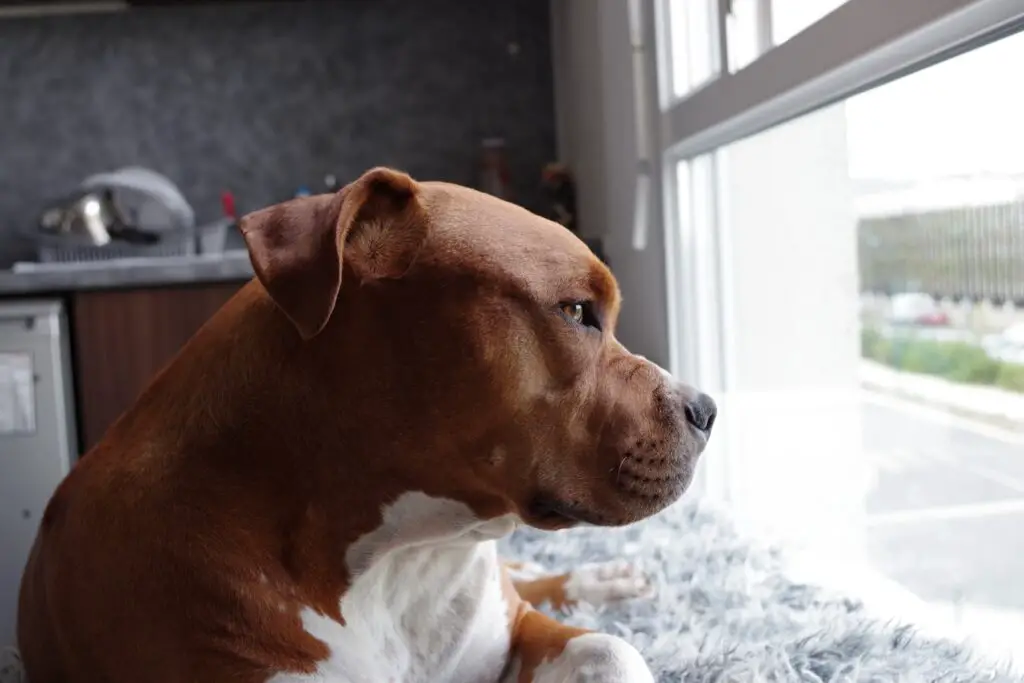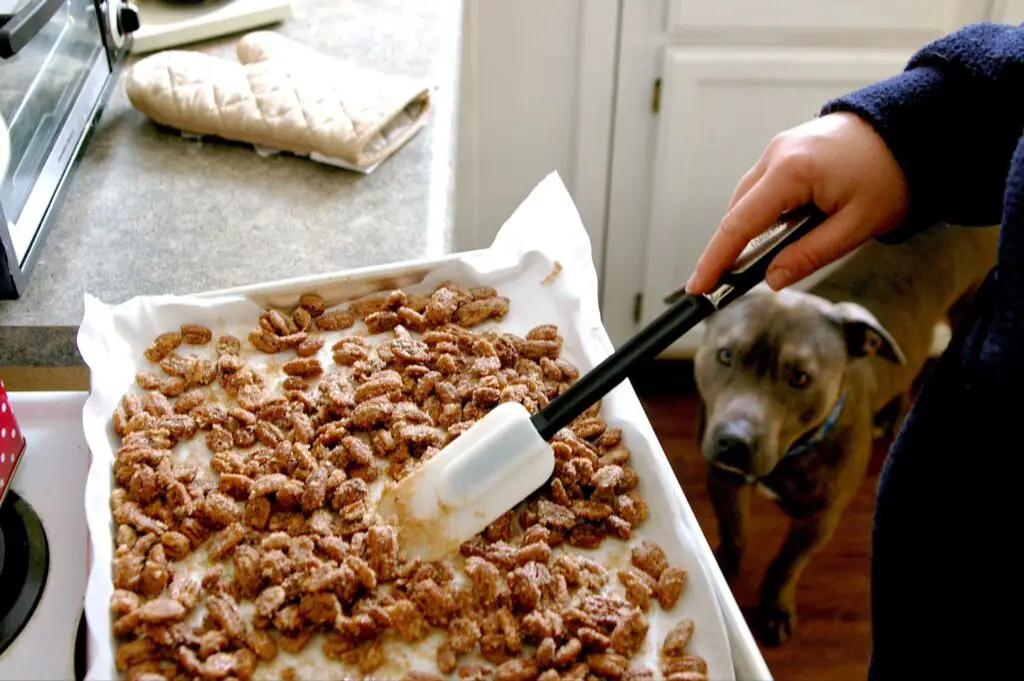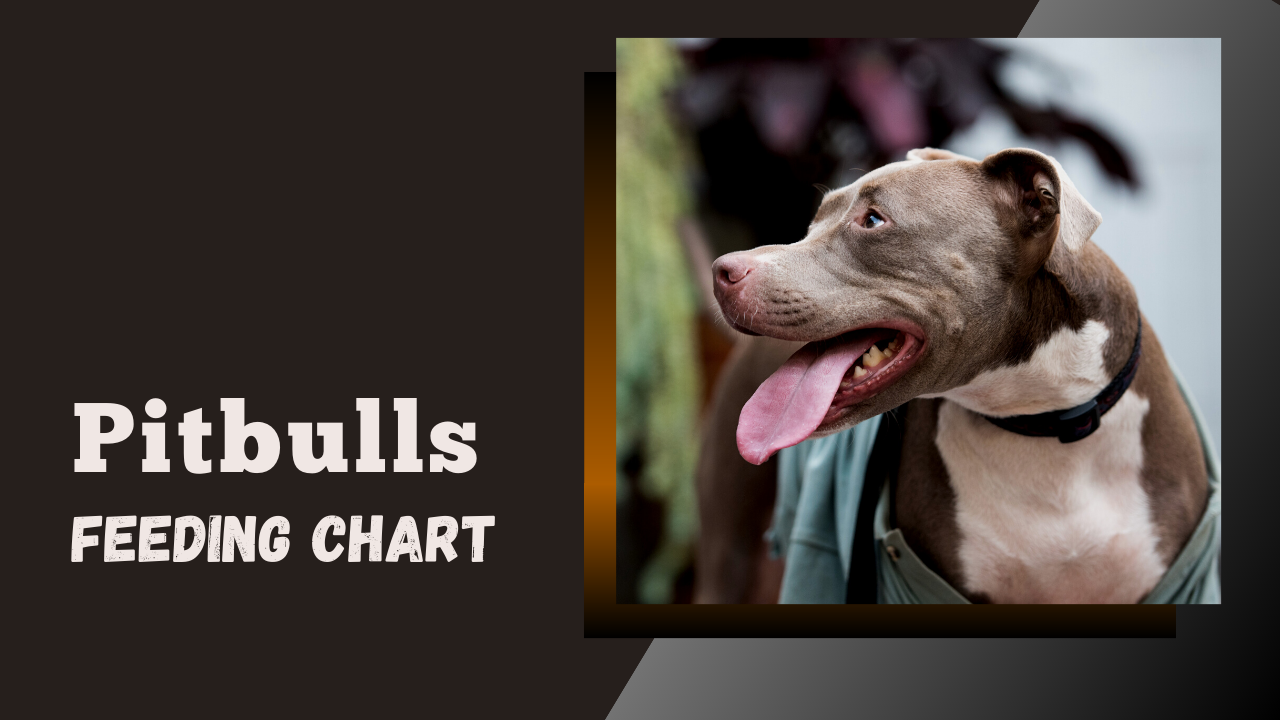Pit bulls are a muscular and highly energetic breed of dogs that require a nutritious, well-balanced diet to remain healthy and strong. Apart from their overall health, proper feeding also ensures disease prevention throughout your pit bull’s life span.
Here’s more information if you’re wondering what and how much you must feed your canine. The pit bull feeding chart will help you properly plan your dog’s diet. You’ll also read about their nutritional needs and some tips for feeding them.
Pit Bulls Feeding Chart
The pit bull’s feeding chart depends on age, weight, and activity level. Here are the general guidelines for feeding your adult pit bull:
| Weight (in lbs) | Amount of food (in cups/day) |
| 20 – 30 | 1.5 – 2 |
| 30 – 40 | 2 – 2.5 |
| 40 – 60 | 2.5 – 3.5 |
| 60 – 80 | 3.5 – 4.5 |
| 80 – 100 | 4.5 – 5.5 |
Note: This feeding chart is only a guideline. Consider consulting with your veterinarian to know the ideal amount of food you must feed your pitbull based on their individual needs.
The growing pit bull puppies require more frequent feeds than adults. Here’s the general feeding chart for pit bull pups:
| Age (in months) | Amount of food (in cups/day) |
| 2 – 3 | 0.5 – 0.75 |
| 4 – 5 | 0.75 – 1.25 |
| 6 – 9 | 0.67 – 1.33 |
| 10 – 12 | 1.25 – 1.5 |
Feeding a pit bull puppy 3-4 times per day is recommended. Puppies should be fed three or four times a day until they reach six months of age; after that, two meals per day are sufficient. This caters to their high energy needs since they’re growing and developing.
- Below four months of age: four meals daily
- Between 4 – 6 months: three meals daily
- Over six months: 2 – 3 meals daily
An adult pit bull should be fed twice daily, with the amount of food depending on its size and activity level. An adult pit bull’s ideal daily caloric intake is between 1,200 and 1,600 calories daily.
Pit bulls should be fed twice daily, once in the morning and once at night.
Depending on your pup’s activity level, age, and weight, you may need to adjust your feed amount. A good rule of thumb is to provide your pitbull half a cup of food for every 25 pounds of body weight.
If your dog is particularly active, consider increasing their food intake accordingly.
Introducing New Food to Your Puppy
When you bring home a pit bull puppy, it’s vital to feed them the same food that they were provided by the breeder (or shelter). You must continue this for at least two weeks; this gives your pup time to settle into their new home.
To transition to your choice of puppy food, mix about 10% of the new food with 90% of the old food on day one. Then, slowly increase the new food’s quantity while reducing the old one over the week. This slow change helps prevent upsetting your pup’s tummy.
Helpful tip: Add probiotics to your pup’s food once daily to aid in better digestion.
Nutritional Requirements for Pit Bulls
Pit bulls require a nutritionally well-balanced diet that contains essential minerals and vitamins, is high in protein, and is low in fat.

To help maintain their physique and activity levels, this active breed needs a diet that can provide them with the necessary energy.
Vitamins and Minerals: Pit bulls need calcium, phosphorous, and vitamin D to help maintain healthy teeth, bones, and overall growth.
Carbohydrates: Pit bulls get their energy from the carbohydrates in their diet. However, you must look for low glycemic index carbohydrates, like brown rice and sweet potatoes.
Avoid feeding them food with high amounts of wheat or corn; these may cause digestive problems and allergies.
Fat: You must include fat in moderation in your pit bull’s diet. Too much fat can cause obesity and other health problems. Look for a diet plan containing no more than 15% fat.
Protein: Your pit bull’s diet should be protein-rich; the proteins help build and repair muscles. Include at least 25% protein in their diet with high-quality sources like chicken, fish, beef, and lamb.
Meeting the Nutritional Needs of Pit Bulls
Feeding your pit bull a natural, whole-food diet will help keep them healthy and happy.
High-quality dry kibble is the best choice for feeding a pit bull, as it provides all the necessary nutrients in an easily digestible form. Studies have shown that more expensive kibble is often easily digestible.
Wet food, a commercial dog food, contains about 75% water. This moisture brings out all the aromas of the food, making it highly palatable for most dogs. However, wet food also spoils faster.
Helpful tip: Avoid feeding wet food in large amounts, as some dogs may have loose stools.
Fresh fruits and vegetables can also be added to your pup’s diet in moderation if cut into small pieces and cooked before feeding them to your pet.
Here are some options to consider for feeding your pit bull:
Store-bought food: An easy choice; you can check the ingredients at the back to ensure they’re getting the proper nutrition. These foods also come with a feeding chart you can follow for your pit bull’s daily intake.
- Wet food: Ensure the packaging says “complete” food, not “complementary” food. It’s recommended to mix this with dry food.
- Kibble: Easy to shop for and more long-lasting than wet food, kibble comes in many flavors. Consider shopping for one with all-natural ingredients.
- Grain-free kibble: Although more expensive, it is rich in proteins and fulfills your pit bull’s dietary needs. Meat is the main ingredient in this type of food.
Homemade food: If you prefer preparing dog food by yourself, you must pick the right ingredients, know the composition, and know how to divide them through the meals properly.

Consider including meat, dairy products, fruits, vegetables, fish, white rice, peanut butter, etc.
- Raw diet (BARF): Biologically appropriate raw foods (BARF) diet, with raw meat, bones, and vegetables, while neither scientifically proven nor denied, could be a good option for your pit bull.
Be careful when choosing a raw diet; it’s often far too rich for a puppy’s stomach.
Dog Supplements for Your Pit Bull
While a natural, good-quality raw food diet is excellent for your pit bull’s well-being, you can consider dietary supplements to take their nutrition to the next level.
Pit bulls have a higher risk of developing joint issues and hip dysplasia. You might use supplements to avoid these issues. However, check with your vet before introducing supplements to your pit bull’s diet.
Creating a Balanced Diet for Pit Bulls
While you can go with commercial dog food (kibble, wet food, or both), you can also prepare your pup’s meals (raw or cooked). If you opt to cook, you must assemble a complete, well-balanced meal plan.
Take extra care while feeding your pit bull pup; they might have a sensitive tummy or food-related allergies that could manifest as skin problems. Always look out for allergies when experimenting with any new ingredients.
Helpful tip: Avoid ingredients like wheat, soy, corn, and glucose or fructose syrups.
Here are some recommendations to consider:
- Protein: Include 22-32% protein with eggs, fish, turkey, duck, poultry, or rabbit. Limit beef and lamb and avoid pork or pork products.
- Carbohydrates: Include 35-45% carbs with grains (rice, oatmeal, barley, etc.), vegetables, sweet potatoes, lentils, and peas.
- Fiber: Include 2.4-5.6% fiber with fruits and vegetables. Lettuce, strawberries, carrots, ground flaxseed, apples, green beans, spinach, and beet pulp are good.
- Omega fatty acids: Include 11-15% fat; use fish, meat, fish oils, and other healthy oils.
- Vitamins and minerals: Include 0.8-1.4% calcium and 0.7-1.2% phosphorous, and vitamin D and magnesium.
Ensuring Proper Nutrition for Pit Bulls’ Health
Whatever food you choose for your pit bull, the most important thing is to ensure it meets its nutritional needs. It is essential to monitor your pup’s weight regularly and adjust their portion sizes accordingly if needed.
Tips for Feeding Pit Bulls
Here are some helpful tips to remember when feeding your pit bull.
Choose high-quality food: Good dry dog food should make up most of their diet; however, wet food can also be included as part of their meal plan.
Limit the treats: Treats should only make up 10% or less of your pup’s daily calorie intake.
Avoid overfeeding your pit bull: Pit bulls tend to overeat, leading to obesity and other health issues. They should have a waistline when viewed from above and ribs that can be felt but not seen when touched lightly.
Provide plenty of fresh water: Fresh water must always be available to keep your dog hydrated throughout the day.
Feed them at the same time every day: Pit bulls thrive on routine; ensure you feed your pit bull at the same time every day. It helps establish a regular eating schedule, reducing the likelihood of overeating.
Final Thoughts
Pit bulls are active, energetic dogs that require a balanced diet to stay healthy.
It’s important to provide high-quality dog food that contains all the necessary nutrients for a healthy diet. Always ensure plenty of fresh water is available for your pup throughout the day.
Treats can also be given as part of their daily diet but should not exceed 10% of their daily caloric intake.
If you’re unsure about how much or what type of food to give your pit bull, consult with your veterinarian for advice. You can ask for an appropriate feeding plan tailored specifically for them.


